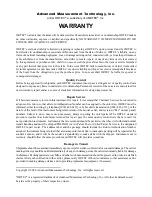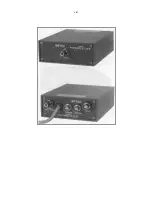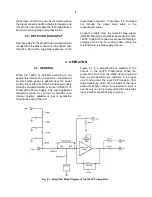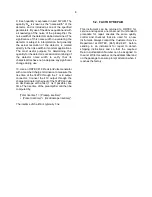
5
CAUTION
Do not use a metal screwdriver for this adjustment;
there is a possibility of high-bias leakage on the
printed circuit that could cause a severe shock.
4.2. DETECTOR BIAS
The amount of bias required to operate the
proportional counter is specified in the data that are
furnished with it. The bias that is accepted into the
preamplifier through the SHV Bias connector is
furnished through the load resistance (about 30
megohms) to the Input SHV connector of the
preamplifier. If the leakage current through the
proportional counter is appreciable, a notable volt-
age drop will occur across the series load resistance
in the preamplifier, and this must be added to the
detector requirement when the bias supply level is
adjusted.
With the protection circuit in, the input cable can be
removed and reconnected without catastrophic
damage to the preamplifier even when bias is
applied to the circuit; but the user must be very
cautious to prevent touching the interior of the
connector with anything other than a good insulator
because potentially lethal high voltage can be
present on the center pin of the Input connector
under these conditions.
With the protection circuit out, the operating bias
level must be reduced gradually to zero before
the proportional counter is either connected to or
disconnected from the Input connector on the
142PC.
4.3. ENERGY OUTPUT
The charge-sensitive loop is essentially an
operational amplifier with a capacitive feedback
that depends on the stray capacitance of the
feedback resistor; the value of this feedback is
approximately 0.15 pF. The conversion gain is
approximately 300 mV/MeV. If less conversion gain
is desired, a capacitor can be added across the
feedback resistor. Up to 2 pF may be added without
seriously affecting the stability of the preamplifier.
If the feedback is increased to about 1 pF, the
conversion gain is reduced to around 45 mV/MeV.
The energy output signal from the preamplifier is a
fast risetime voltage step with an exponential return
to the baseline in about 75
:
s. The polarity of
signals through the E output is inverted from the
signal polarity at the output of the proportional
counter. When the (normal) positive bias polarity is
used for the detector, its output pulses are negative
and the E output of the preamplifier is positive.
4.4. TIMING OUTPUT
The T output connector provides an alternate path
for the same output pulses that are furnished
through the E output connector. The intent is to
provide both connections for convenience when the
142PC Preamplifier is used to drive two systems -
one for energy spectroscopy and the other for
timing spectroscopy.
4.5. COMPENSATION ADJUSTMENT
A bandwidth compensation control is accessible to
the user of the 142PC. This control can be adjusted
through the bottom of the case without opening the
unit. It is used to tune the preamplifier to the
particular proportional counter that is connected in
order to obtain the fastest risetime for the best time
resolution. Although a fast risetime is not
necessary for energy measurements, a typical
timing experiment will provide the best timing
resolution when the rise time is optimized with this
control. Because of the high voltages that are
present inside the case when the preamplifier is
operating, a small plastic screwdriver or a TV tuning
tool should be used for this adjustment.
When the 142PC Preamplifier is shipped from the
factory, the compensation adjustment has been set
for the specified rise time for a 0-pF input
capacitance; For optimum results for other input
capacities, the control should be adjusted under
actual operating conditions.
If the control has been adjusted for optimum
bandwidth for a specific input capacity and the input
circuit is then changed to provide less capacity,
control readjustment is necessary so that the
preamplifier will not oscillate. If the input capacity is
increased from the value for which the adjustment
has been made, the preamplifier should be stable
and should not oscillate.
Summary of Contents for 142PC
Page 4: ...iv...
Page 8: ...viii...


































